Config
The Config custom resource can be provided by a vendor to specify a Config page in the Replicated admin console for collecting customer supplied values and template function rendering.
The settings that appear on the admin console Config page are specified as an array configuration groups and items.
The following example shows three groups defined in the Config custom resource manifest file, and how these groups are displayed on the admin console Config page.
For more information about the properties of groups and items, see Group Properties and Item Properties below.
spec:
groups:
- name: example_group
title: First Group
description: This is descriptive help text.
items:
- name: http_enabled
title: HTTP Enabled
type: bool
default: "0"
- name: example_group_2
title: Second Group
description: This is descriptive help text.
when: false
items:
- name: key
title: Key
type: textarea
props:
rows: 8
- name: hostname
title: Hostname
type: text
- name: example_group_3
title: Third Group
description: This is descriptive help text.
items:
- name: email-address
title: Email Address
type: text
- name: password_text
title: Password
type: password
value: "{{repl RandomString 10}}"
 View a larger version of this image
View a larger version of this image
Group Properties
Groups have a name, title, description and an array of items.
name
A unique identifier for the group.
spec:
groups:
# The name must be unique
- name: example_group
title: First Group
description: This is descriptive help text.
items:
- name: http_enabled
title: HTTP Enabled
type: bool
default: "0"
title
The title of the group that displays on the admin console Config page.
spec:
groups:
- name: example_group
# First Group is the heading that appears on the Config page
title: First Group
description: This is descriptive help text.
items:
- name: http_enabled
title: HTTP Enabled
type: bool
default: "0"
description
Descriptive help text for the group that displays on the admin console Config page. Supports markdown formatting.
To provide help text for individual items on the Config page, use the item help-text property. See help_text below.
spec:
groups:
- name: example_group
title: First Group
# Provide a description of the input fields in the group
description: Select whether or not to enable HTTP.
items:
- name: http_enabled
title: HTTP Enabled
type: bool
default: "0"
when
The when property denotes conditional user inputs that are only displayed on the admin console Config page when a condition evaluates to true. The equality check in the conditional statement of the when property must match exactly, without quotes.
The when property can be used on groups, items, and select_one options.
When the when property for a group or item evaluates to false, the group or item is not displayed on the Config page.
If the user provides input on the Config page that makes a when property evaluate to true, then the Config page updates immediately to display the previously hidden group or item.
spec:
groups:
- name: example_group
title: First Group
description: This is descriptive help text.
items:
- name: http_enabled
title: HTTP Enabled
type: bool
default: "0"
- name: example_group_2
title: Second Group
description: This is descriptive help text.
# The group is not displayed if when is false
when: repl{{ ConfigOptionEquals "http_enabled" "1" }}
items:
- name: key
title: Key
type: textarea
props:
rows: 8
- name: hostname
title: Hostname
type: text
- name: example_group_3
title: Third Group
description: This is descriptive help text.
items:
- name: email-address
title: Email Address
type: text
- name: password_text
title: Password
type: password
value: "{{repl RandomString 10}}"
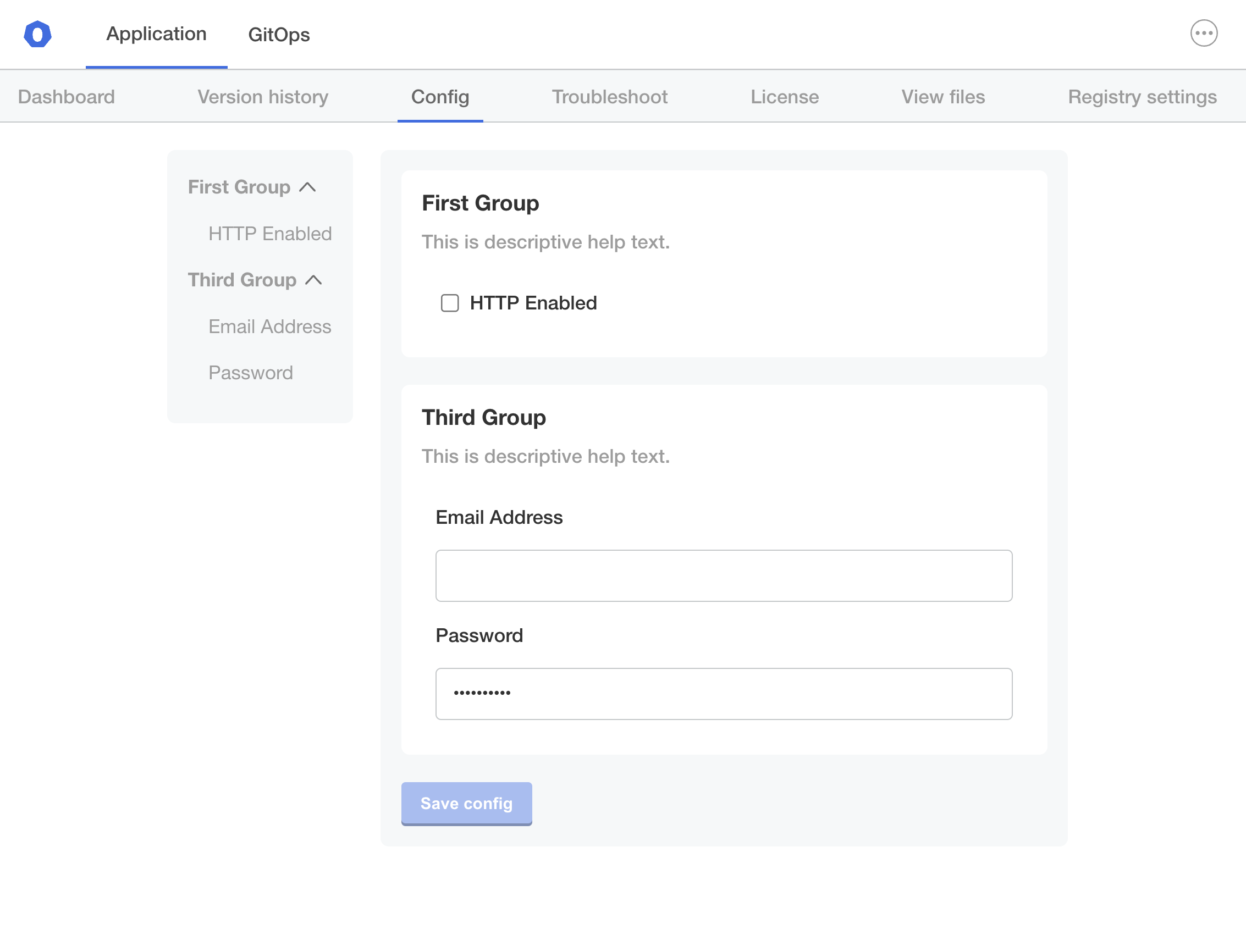 View a larger version of this image
View a larger version of this image
items
Each group contains an array of items that map to input fields on the admin console Config screen. All items have name, title, and type properties and belong to a single group.
For more information, see Item Properties and Item Types below.
Item Properties
Items have a name, title, type, and other optional properties.
name
A unique identifier for the item. Each item in the Config custom resource much have a unique name, including items in different groups.
items:
# Item names must be unique both within the group and across all groups
- name: http_enabled
title: HTTP Enabled
type: bool
default: "0"
title
The title of the item that displays on the admin console Config page.
items:
- name: http_enabled
# HTTP Enabled is the title for the input field on the Config page
title: HTTP Enabled
type: bool
default: "0"
type
Each item has a type property that defines the type of user input accepted by the field.
The following are the possible values for the type property:
boolfileheadinglabelpasswordselect_onetexttextarea
For information about each type, see Item Types.
items:
- name: http_enabled
title: HTTP Enabled
# type identifies the input type
type: bool
default: "0"
default and value
A default value will be applied to the ConfigOption template function when no value is specified.
If default value is not a password field, it will appear as placeholder text in the settings section of the admin console.
Default values are treated as ephemeral, which is the same behavior as the readonly property.
Configuration changes will re-evaluate the template expressions.
A value is data that will be overwritten by user input on non-readonly fields.
It will appear as the HTML input value in the settings section of the admin console.
- name: custom_key
title: Set your secret key for your app
description: Paste in your Custom Key
items:
- name: key
title: Key
type: text
value: ""
default: change me
required
A required field will prevent the application from starting until it has a value.
required: true
when
The when property denotes conditional user inputs that are only displayed on the admin console Config page when a condition evaluates to true. The equality check in the conditional statement of the when property must match exactly, without quotes.
The when property can be used on groups, items, and select_one options.
When the when property for a group or item evaluates to false, the group or item is not displayed on the Config page.
If the user provides input on the Config page that makes a when property evaluate to true, then the Config page updates immediately to display the previously hidden group or item.
- name: database_settings_group
items:
- name: db_type
type: select_one
default: external
items:
- name: external
title: External
- name: embedded
title: Embedded DB
- name: database_host
title: Database Hostname
type: text
when: '{{repl (ConfigOptionEquals "db_type" "external")}}'
- name: database_password
title: Database Password
type: password
when: '{{repl (ConfigOptionEquals "db_type" "external")}}'
recommended
An item can be recommended. This item will bear the tag "recommended" in the admin console.
Note: Only works for boolean and text field types.
- name: group_title
title: Group Title
items:
- name: http_enabled
title: HTTP Enabled
type: bool
default: "0"
recommended: true
hidden
Items can be hidden. They will not be visible if hidden.
- name: secret_key
title: Secret Key
type: password
hidden: true
value: "{{repl RandomString 40}}"
When you assign a template function that generates a value to a value key in the Config custom resource, you can use the readonly and hidden properties to define whether or not the generated value is ephemeral or persistent between changes to the configuration settings for the application. For more information, see RandomString in Static Context.
readonly
Items can be readonly.
- name: unique_id
title: Unique ID
type: text
value: "{{repl RandomString 20}}"
readonly: true
When you assign a template function that generates a value to a value key in the Config custom resource, you can use the readonly and hidden properties to define whether or not the generated value is ephemeral or persistent between changes to the configuration settings for the application. For more information, see RandomString in Static Context.
affix
Items can be affixed left or right. These items will appear in the admin console on the same line.
affix: left
help_text
This is similar to description but for items.
This property can show a helpful message below title.
Markdown syntax is supported.
- name: toggles
items:
- name: http_enabled
title: HTTP Enabled
help_text: Check to enable the HTTP listener
type: bool
Item Types
The section describes each of the item types:
boolfileheadinglabelpasswordselect_onetexttextarea
bool
The bool input type should use a "0" or "1" to set the value
- name: group_title
title: Group Title
items:
- name: http_enabled
title: HTTP Enabled
type: bool
default: "0"

file
A file is a special type of form field that renders an <input type="file" /> HTML element.
Only the contents of the file, not the name, are captured.
See the ConfigOptionData template function for examples on how to use the file contents in your application.
- name: certs
title: TLS Configuration
items:
- name: tls_private_key_file
title: Private Key
type: file
- name: tls_certificate_file
title: Certificate
type: file
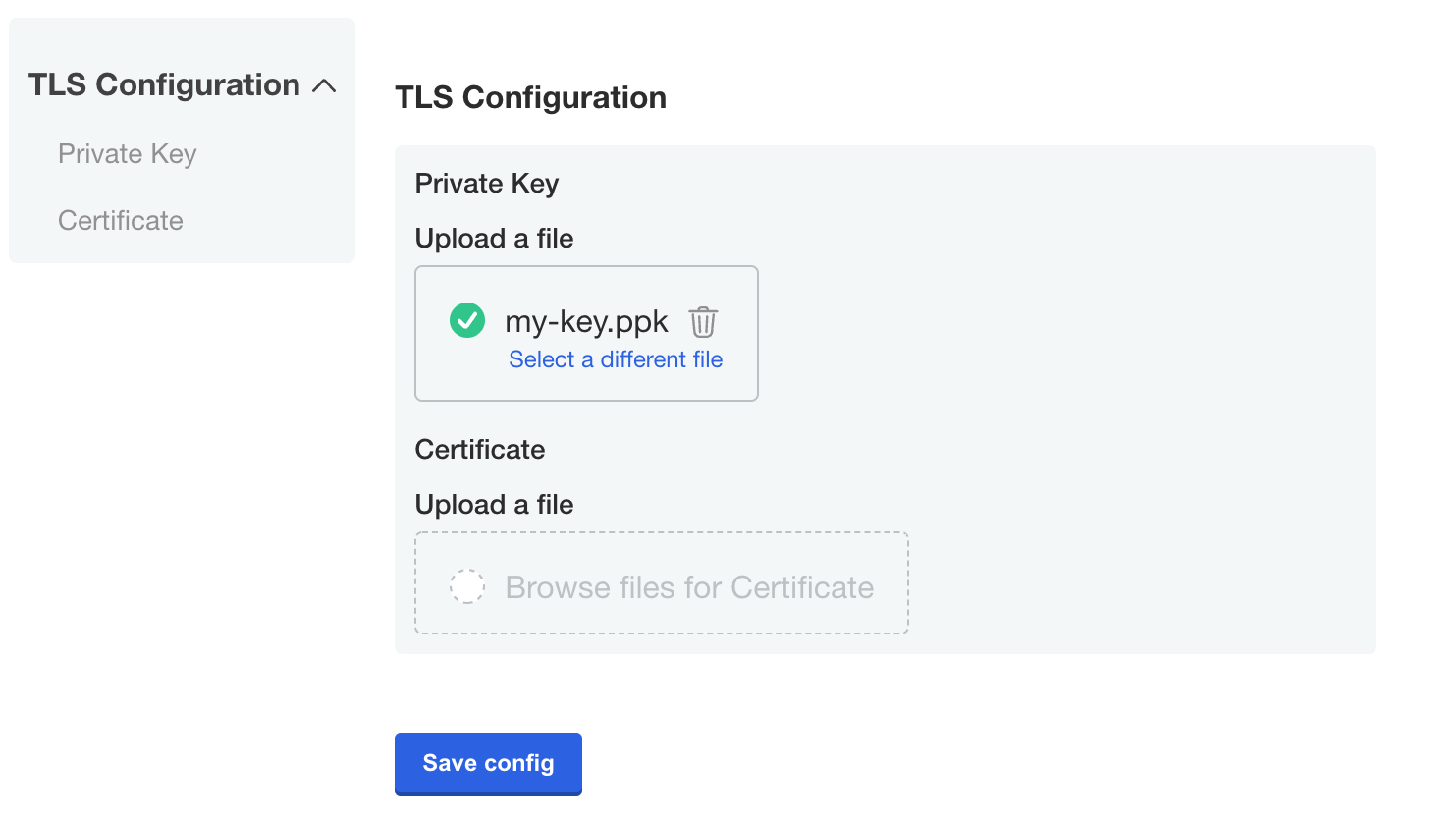
heading
The heading type allows you to display a group heading as a sub-element within a group.
This is useful when you would like to use a config group to group items together, but still separate the items visually.
Note: The heading item type is not supported.
- name: ldap_settings
title: LDAP Server Settings
items:
...
- name: ldap_schema
type: heading
title: LDAP schema
...

label
The label type allows you to display an input label.
- name: email
title: Email
items:
- name: email-address
title: Email Address
type: text
- name: description
type: label
title: "Note: The system will send you an email every hour."
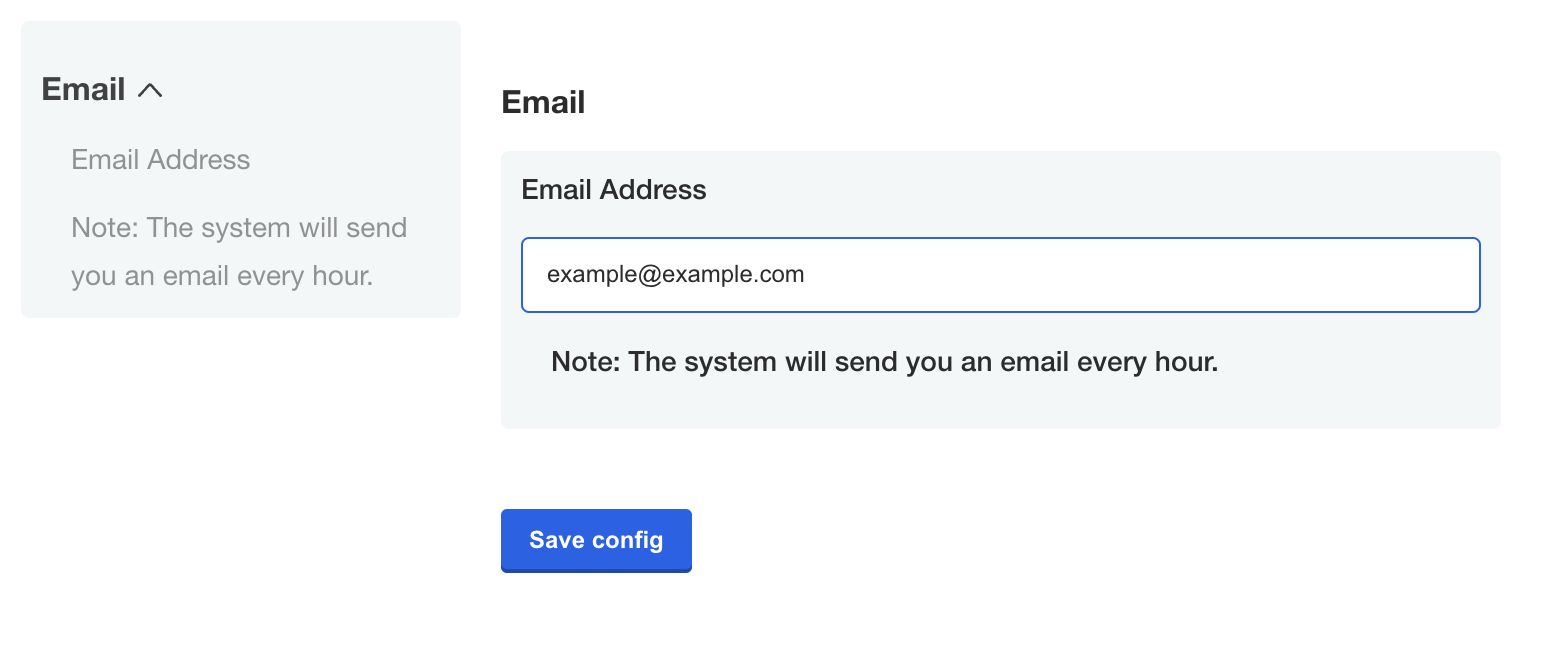
password
The password type is a text field that hides the character input.
- name: password_text
title: Password Text
type: password
value: "{{repl RandomString 10}}"
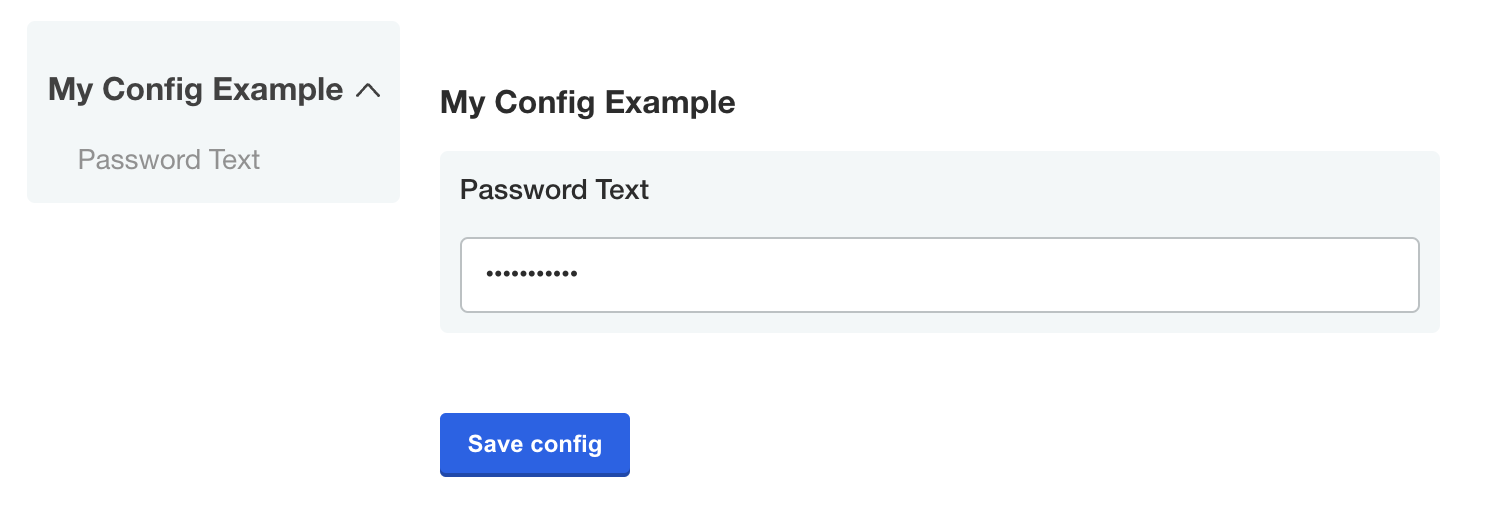
select_one
The select_one type is a special case.
This type must have nested items that act as options.
This type is displayed as radio buttons in the admin console.
- name: authentication
title: Authentication
description: ""
items:
- name: authentication_type
default: authentication_type_anonymous
type: select_one
items:
- name: authentication_type_anonymous
title: Anonymous
- name: authentication_type_password
title: Password

text
A text input field allows users to enter a string value.
Optionally, all additional properties are available for this input type.
- name: example_text_input
title: Example Text Input
type: text
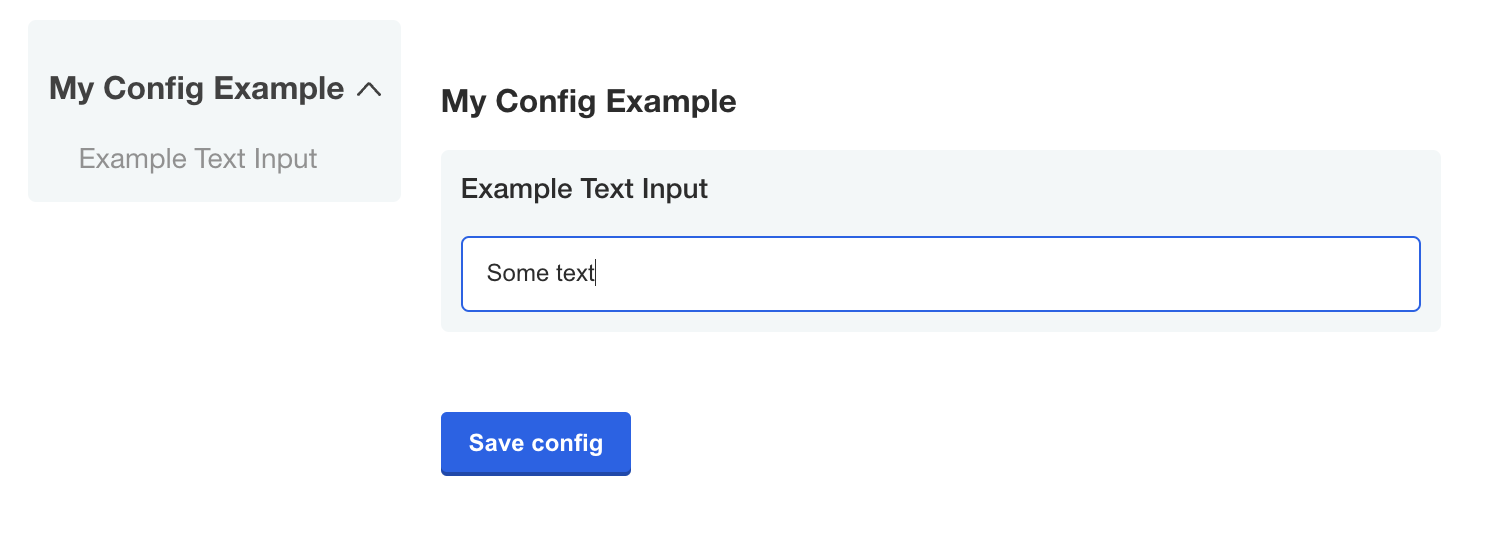
textarea
A textarea can specify a props that will map into the HTML element directly.
Examples of available properties are rows, cols and wrap.
For more information, see HTML <textarea/> Tag.
- name: custom_key
title: Set your secret key for your app
description: Paste in your Custom Key
items:
- name: key
title: Key
type: textarea
props:
rows: 8
- name: hostname
title: Hostname
type: text

Repeatable Items
A repeatable config item copies a YAML array entry or YAML document for as many values as are provided. Any number of values can be added to a repeatable item to generate additional copies.
Note: Repeatable Items only work for text, textarea, and file types.
To make an item repeatable, set repeatable to true
- name: ports
items:
- name: service_port
title: Service Port
type: text
repeatable: true
Repeatable items do not use the default or value fields, but instead a valuesByGroup field.
valuesByGroup should have an entry for the parent Config Group name, with all default key:value pairs nested in the group. At least one default entry is required for the repeatable item.
valuesByGroup:
ports:
port-default-1: "80"
Template Targets
Repeatable items require at least 1 template to be provided. The template defines a YAML target in the manifest to duplicate for each repeatable item.
Required fields for a template target are apiVersion, kind, and name.
namespace is an optional template target field to match a yaml document's metadata.namespace property, in case the same filename is used across multiple namespaces.
The entire YAML node at the target will be duplicated, including nested fields.
The yamlPath field of the template must denote index position for arrays using square brackets. For example, spec.ports[0] to select the first port entry for duplication. All duplicate YAML will be appended to the final array in the yamlPath.
yamlPath must end with an array.
templates:
- apiVersion: v1
kind: Service
name: my-service
namespace: my-app
yamlPath: 'spec.ports[0]'
If the yamlPath field is not present, the entire YAML document matching the template will be replaced with a copy for each of the repeatable item entries. The metadata.name field of the new doc will reflect the repeatable item key.
Templating
The repeat items are called with the delimeters repl[[ .itemName ]] or [[repl .itemName ]]. These delimiters can be placed anywhere inside of the yamlPath target node.
- port: repl{{ ConfigOption "[[repl .service_port ]]" | ParseInt }}
name: '[[repl .service_port ]]'
This repeatable templating is not compatible with sprig templating functions. It is designed for inserting repeatable keys into the manifest. Repeatable templating can be placed inside of Replicated config templating.
Ordering
Repeatable templates are processed before config template rendering.
Repeatable items are processed in order of the template targets in the Config Spec file. Effectively, this ordering is from the top of the Config Spec, by Config Group, by Config Item, and then by template target.
- name: ports
items:
- name: service_port
title: Service Port
type: text
repeatable: true
templates:
- apiVersion: v1 #processed first
kind: Service
name: my-service
namespace: my-app
yamlPath: 'spec.ports[0]'
- apiVersion: v1 #processed second
kind: Service
name: my-service
namespace: my-app
{other item properties ...}
- name: other_ports
title: Other Service Port
type: text
repeatable: true
templates:
- apiVersion: v1 #processed third
kind: Service
name: my-other-service
namespace: my-app
{other item properties ...}
- name: deployments
items:
- name: deployment-name
title: Deployment Names
type: text
repeatable: true
templates:
- apiVersion: apps/v1 #processed fourth
kind: Deployment
name: my-deployment
namespace: my-app
{other item properties ...}
Repeatable Examples
In these examples, the default service port of "80" is included with the release. Port 443 is added as an additional port on the admin console configuration page, which is stored in the ConfigValues file.
Repeatable Item Example for a YamlPath
Config custom resource manifest file
- name: ports
items:
- name: service_port
title: Service Port
type: text
repeatable: true
templates:
- apiVersion: v1
kind: Service
name: my-service
namespace: my-app
yamlPath: spec.ports[0]
valuesByGroup:
ports:
port-default-1: "80"
Config values
apiVersion: kots.io/v1beta1
kind: ConfigValues
metadata:
name: example_app
spec:
values:
port-default-1:
repeatableItem: service_port
value: "80"
service_port-8jdn2bgd:
repeatableItem: service_port
value: "443"
Template manifest
apiVersion: v1
kind: Service
metadata:
name: my-service
namespace: my-app
spec:
type: NodePort
ports:
- port: repl{{ ConfigOption "[[repl .service_port ]]" | ParseInt }}
name: '[[repl .service_port ]]'
selector:
app: repeat_example
component: my-deployment
After repeatable config processing
Note: this phase is internal to configuration rendering for the app manager. This example is only provided to further explain the templating process.*
apiVersion: v1
kind: Service
metadata:
name: my-service
namespace: my-app
spec:
type: NodePort
ports:
- port: repl{{ ConfigOption "port-default-1" | ParseInt }}
name: 'port-default-1'
- port: repl{{ ConfigOption "service_port-8jdn2bgd" | ParseInt }}
name: 'service_port-8jdn2bgd'
selector:
app: repeat_example
component: my-deployment
Resulting manifest
apiVersion: v1
kind: Service
metadata:
name: my-service
namespace: my-app
spec:
type: NodePort
ports:
- port: 80
name: port-default-1
- port: 443
name: service_port-8jdn2bgd
selector:
app: repeat_example
component: my-deployment
Repeatable Item Example for an Entire Document
Config spec
- name: ports
items:
- name: service_port
title: Service Port
type: text
repeatable: true
templates:
- apiVersion: v1
kind: Service
name: my-service
namespace: my-app
valuesByGroup:
ports:
port-default-1: "80"
Config values
apiVersion: kots.io/v1beta1
kind: ConfigValues
metadata:
name: example_app
spec:
values:
port-default-1:
repeatableItem: service_port
value: "80"
service_port-8jdn2bgd:
repeatableItem: service_port
value: "443"
Template manifest
apiVersion: v1
kind: Service
metadata:
name: my-service
namespace: my-app
spec:
type: NodePort
ports:
- port: repl{{ ConfigOption "[[repl .service_port ]]" | ParseInt }}
selector:
app: repeat_example
component: repl[[ .service_port ]]
After repeatable config processing
Note: this phase is internal to configuration rendering for the app manager. This example is only provided to further explain the templating process.*
apiVersion: v1
kind: Service
metadata:
name: port-default-1
namespace: my-app
spec:
type: NodePort
ports:
- port: repl{{ ConfigOption "port-default-1" | ParseInt }}
selector:
app: repeat_example
component: port-default-1
---
apiVersion: v1
kind: Service
metadata:
name: service_port-8jdn2bgd
namespace: my-app
spec:
type: NodePort
ports:
- port: repl{{ ConfigOption "service_port-8jdn2bgd" | ParseInt }}
selector:
app: repeat_example
component: service_port-8jdn2bgd
Resulting manifest
apiVersion: v1
kind: Service
metadata:
name: port-default-1
namespace: my-app
spec:
type: NodePort
ports:
- port: 80
selector:
app: repeat_example
component: port-default-1
---
apiVersion: v1
kind: Service
metadata:
name: service_port-8jdn2bgd
namespace: my-app
spec:
type: NodePort
ports:
- port: 443
selector:
app: repeat_example
component: service_port-8jdn2bgd